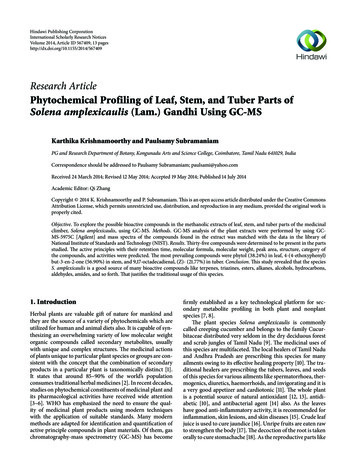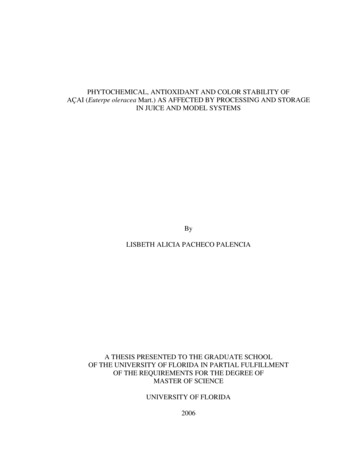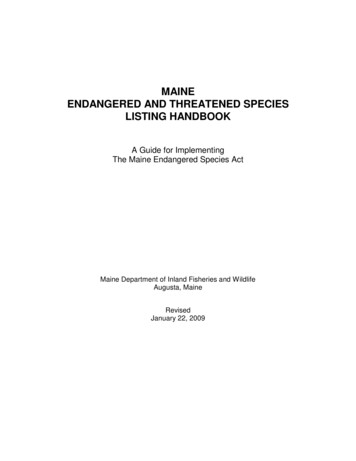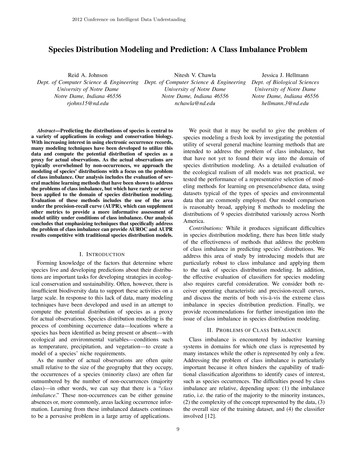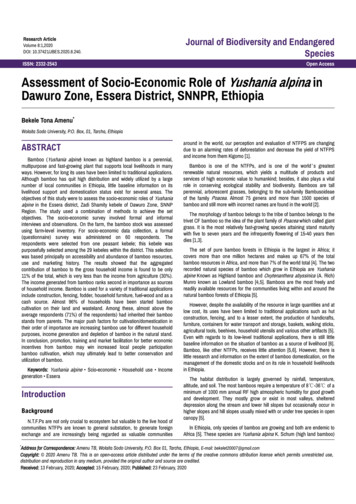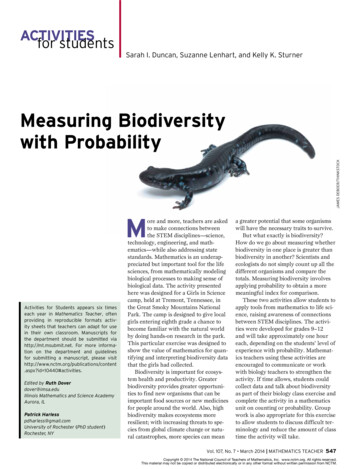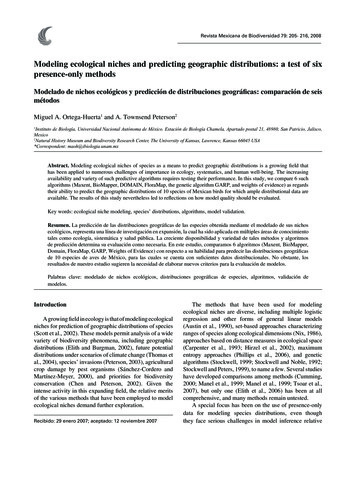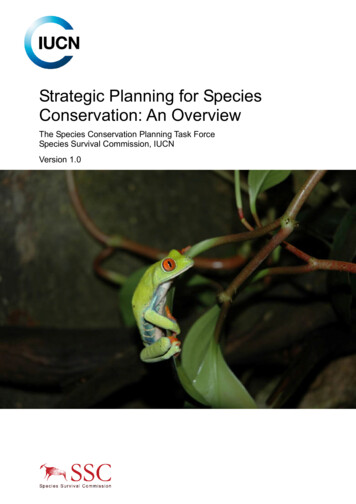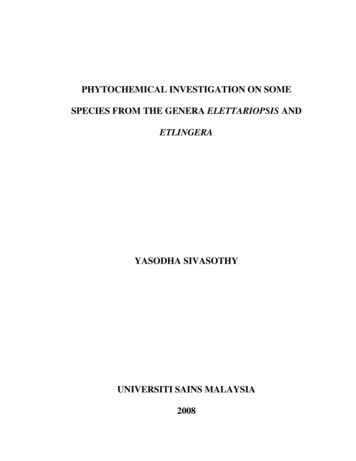
Transcription
PHYTOCHEMICAL INVESTIGATION ON SOMESPECIES FROM THE GENERA ELETTARIOPSIS ANDETLINGERAYASODHA SIVASOTHYUNIVERSITI SAINS MALAYSIA2008
PHYTOCHEMICAL INVESTIGATION ON SOME SPECIES FROMTHE GENERA ELETTARIOPSIS AND ETLINGERAbyYASODHA SIVASOTHYThesis submitted in fulfillment of therequirements for the Degree ofDoctor of PhilosophyMAY 2008
ACKNOWLEDGEMENTFirstly, I would like to take this opportunity to thank my supervisor, Assoc. Prof. Dr. WongKeng Chong for his advice and guidance. I am also thankful to my co-supervisor, Prof. Dr.Boey Peng Lim for his encouragement and helpful suggestions throughout the course of thisstudy.Next, I would like to acknowledge the Dean of the Institute of Graduate Studies (IPS) forgiving me a chance to pursue my postgraduate studies in USM. Special thanks to the Deanof the School of Chemical Sciences, Prof. Dr. Wan Ahmad Kamil Mahmood for providingme with the assistance and facilities which ensured the success of my research.I would also like to thank Institut Pengajian Siswazah for awarding me with the GraduateAssistant Scheme which covered my allowance and my tuition fee.I am very grateful to Datuk Lim Chong Keat from FRIM and Mr. Baharuddin Sulaimanfrom the School of Biological Sciences, USM for providing me with the plant materials andin the identification of them for my research. I would also like to thank Mr. Shanmugamfrom the School of Biological Sciences, USM for helping me prepare the voucher specimensfor certain of those species.I would like to forward my appreciation to the technical and laboratory staffs of the Schoolof Chemical Sciences, in particular, Mr. Chow Cheng Por, Mr. Clement D’Silva, Mr. TanChin Tong, Mr. Megat Hasnul, Mr. Yee Chin Leng, Mr. Chee Sai Gnow, Mr. Aw Yeongand Mr. Mohd. Fahmi Mohd. Yusoff for their assistance during the duration of this study.ii
I would like to acknowledge Mr. Khoo Kay Hock and Mr. Hilman from the Centre for DrugResearch, USM for their help with the GC-MS analyses.Special thanks to Madam Wong Lai Kwai and Madam Han Yan Hui from the Departmentof Chemistry, National University of Singapore for their help with the DP-MS and the NMRanalyses.I would also like to thank my colleagues and friends for their cooperation and moral supportthroughout this project.Finally, I would like to convey my deepest gratitude to my parents for their love andencouragement.iii
TABLE OF CONTENTSPageAcknowledgementiiTable of ContentsivList of TablesviiiList of FiguresxiList of SchemesxviList of AbbreviationsxviiList of AppendicesxixAbstrakxxiiAbstractxxivCHAPTER ONE: INTRODUCTION11.1Natural Products Chemistry11.2The Zingiberaceae Family11.2.1The Origin of the Word se and Commercial Importance21.2.5The Genus Elettariopsis41.2.6The Genus Etlingera91.2.7Previous Phytochemical Investigations121.2.7.1 The Genus Elettariopsis121.2.7.2 The Genus Etlingera121.3Research Objectives131.3.1Part 1131.3.2Part 214iv
CHAPTER TWO: MATERIALS AND METHODS152.1Collection of the Plant Materials152.2Chemicals and Reagents152.3Isolation and Analysis of Essential Oils162.3.1Isolation of Essential Oils162.3.2Chromatographic Analysis of the Essential Oils182.3.2.1 Gas Chromatography182.3.2.2 Gas Chromatography-Mass Spectrometry202.3.3Identification of the Essential Oil Components202.3.4Determination of Oil Yield202.4Isolation and Characterization of the Non-Volatile Constituents in the21Leaves, Fruits, Rhizomes and Roots of Etlingera littoralis2.4.12.4.22.4.3Extraction izomes and Roots21Separation Techniques222.4.2.1Thin Layer Chromatography222.4.2.2Column Chromatography222.4.2.3Preparative Thin Layer Chromatography22Isolation and Purification232.4.3.123Leaves2.4.3.1.1 Petroleum Ether Extract232.4.3.224Fruits2.4.3.2.1 Ethyl Acetate Extract242.4.3.2.2 Petroleum Ether Extract242.4.3.325Rhizomes and Rootsv
2.4.42.4.3.3.1 Ethyl Acetate Extract252.4.3.3.2 Petroleum Ether Extract27Structure Elucidation of Isolated Compounds282.4.4.1Melting Point282.4.4.2Infrared Spectroscopy282.4.4.3Gas Chromatography-Mass Spectrometry282.4.4.4Direct Probe-Mass Spectrometry292.4.4.5Nuclear Magnetic Resonance Spectroscopy292.4.4.6Ultra-Violet Spectroscopy (UV) of F1292.4.4.6.1 Preparation of the Stock Solution of F1302.4.4.6.2 Preparation of the Shift Reagent Stock Solutions and Solids302.4.4.6.3 Steps in the UV Spectral Analysis of F1302.4.4.7Ultra-Violet Spectroscopy (UV) of L1, F2 and R4312.4.4.8Optical Rotation31CHAPTER THREE: RESULTS AND DISCUSSION323.1Essential Oil Analysis323.1.1Percentage Yield of Essential Oil323.1.2Chemical Composition of the Various Essential Oils323.1.2.1Essential Oils of Elettariopsis smithiae333.1.2.2Essential Oils of Elettariopsis rugosa373.1.2.3Essential Oils of Elettariopsis elan413.1.2.4Essential Oils of Elettariopsis slahmong453.1.2.5Essential Oils of Elettariopsis triloba483.1.2.6Essential Oils of Elettariopsis curtisii52vi
3.1.2.7Significance of the Essential Oils in the Chemotaxonomic56Studies of the Genus Elettariopsis3.1.2.8Essential Oils of Etlingera littoralis643.1.2.9Essential Oils of Etlingera elatior and Etlingera elatior var.68Thai queen3.2Non-volatile Constituents Isolated from the Leaves, Fruits, Rhizomes and75Roots of Etlingera 2L287Fruits1073.2.2.1F11073.2.2.2F2122Rhizomes and 4R41783.2.3.5R5185CHAPTER FOUR: CONCLUSION204REFERENCES206APPENDICES216LIST OF PUBLICATIONS234vii
LIST OF TABLESPageTable 2.1: Weight of Plant Material and Volume of Distilled Water Used forHydrodistillation17Table 3.1: Percentage Yields of the Essential Oils of the Various Ginger Species32Table 3.2: Constituents of the Essential Oils of the Leaves and Roots ofElettariopsis smithiae34Table 3.3: Percentages of the Various Chemical Classes in the Essential Oils ofthe Leaves and Roots of Elettariopsis smithiae36Table 3.4: Constituents of the Essential Oils of the Leaves and Roots ofElettariopsis rugosa38Table 3.5: Percentages of the Various Chemical Classes in the Essential Oils ofthe Leaves and Roots of Elettariopsis rugosa40Table 3.6: Constituents of the Essential Oils of the Leaves and Roots ofElettariopsis elan42Table 3.7: Percentages of the Various Chemical Classes in the Essential Oils ofthe Leaves and Roots of Elettariopsis elan44Table 3.8: Constituents of the Essential Oils of the Leaves and Roots ofElettariopsis slahmong46Table 3.9: Percentages of the Various Chemical Classes in the Essential Oils ofthe Leaves and Roots of Elettariopsis slahmong47Table 3.10: Constituents of the Essential Oils of the Leaves and Roots ofElettariopsis triloba49Table 3.11: Percentages of the Various Chemical Classes in the Essential Oils ofthe Leaves and Roots of Elettariopsis triloba51Table 3.12: Constituents of the Essential Oils of the Leaves and Roots ofElettariopsis curtisii53Table 3.13: Percentages of the Various Chemical Classes in the Essential Oils ofthe Leaves and Roots of Elettariopsis curtisii55Table 3.14: Composition of the Essential Oils Isolated from Six ElettariopsisSpecies59Table 3.15: Constituents of the Essential Oils of the Leaves, Rhizomes andRoots of Etlingera littoralis65Table 3.16: Percentages of the Various Chemical Classes in the Essential Oils ofthe Leaves, Rhizomes and Roots of Etlingera littoralis67viii
Table 3.17: Constituents of the Essential Oils of the Leaves, Rhizomes andRoots of Etlingera elatior and Etlingera elatior var. Thai queen71Table 3.18: Percentages of the Various Chemical Classes in the Essential Oils ofthe Leaves, Rhizomes and Roots of Etlingera elatior73Table 3.19: Percentages of the Various Chemical Classes in the Essential Oils ofthe Leaves, Rhizomes and Roots of Etlingera elatior var. Thai queen74Table 3.20: 1H NMR (δppm) Assignments and 1H-1H COSY Correlations of L1 inCDCl3, 400 MHz82Table 3.21: 13C NMR (δppm) Assignments and 1H-13C HMQC and 1H-13C HMBCCorrelations of L1 in CDCl3, 75 MHz83Table 3.22: 1H NMR (δppm) Assignments and 1H-1H COSY Correlations of L2 inCDCl3, 400 MHz98Table 3.23: 13C NMR (δppm) Assignments and 1H-13C HMQC and 1H-13C HMBCCorrelations of L2 in CDCl3, 75 MHz99Table 3.24: Important 1H-1H NOESY and 1H-1H ROESY Correlations of L2 inCDCl3, 500 MHz105Table 3.25: UV analysis of F1 in MeOH and the Effects of the Various ShiftReagents107Table 3.26: 1H NMR (δppm) Assignments and 1H-1H COSY Correlations of F1 inCD3OD, 400 MHz120Table 3.27: 13C NMR (δppm) Assignments and 1H-13C HMQC and 1H-13C HMBCCorrelations of F1 in CD3OD, 75 MHz120Table 3.28: Optical Rotations and Melting Points of Naturally OccurringCatechins (Dictionary of Natural Products, 1996)121Table 3.29: IR Spectral Data of F2132Table 3.30: 1H NMR (δppm) Assignments and 1H-1H COSY Correlations of F2 inCDCl3, 400 MHz133Table 3.31: 13C NMR (δppm) Assignments and 1H-13C HMQC and 1H-13CHMBC Correlations of F2 in CDCl3, 75 MHz134Table 3.32: IR Spectral Data of R1147Table 3.33: 1H NMR (δppm) Assignments and 1H-1H COSY Correlations of R1 inCDCl3, 400 MHz148Table 3.34: 13C NMR (δppm) Assignments and 1H-13C HMQC and 1H-13CHMBC Correlations of R1 in CDCl3, 75 MHz149Table 3.35: IR Spectral Data of R2162ix
Table 3.36: 1H NMR (δppm) Assignments and 1H-1H COSY Correlations of R2in CDCl3, 400 MHz162Table 3.37: 13C NMR (δppm) Assignments and 1H-13C HMQC and 1H-13C HMBCCorrelations of R2 in CDCl3, 75 MHz164Table 3.38: 1H NMR (δppm) Assignments and 1H-1H COSY Correlations of R3 inCDCl3, 400 MHz175Table 3.39: 13C NMR (δppm) Assignments and 1H-13C HMQC and 1H-13C HMBCCorrelations of R3 in CDCl3, 75 MHz175Table 3.40: 1H NMR (δppm) Assignments of R4 in CDCl3, 400 MHz184Table 3.41: 13C NMR (δppm) Assignments of R4 in CDCl3, 75 MHz184Table 3.42: IR Spectral Data of R5196Table 3.43: 1H NMR (δppm) Assignments and 1H-1H COSY Correlations of R5 inCDCl3, 400 MHz198Table 3.44: Pyridine-Induced Solvent Shifts of the Proton Signals Characteristicof R5, 400 MHz198Table 3.45: 13C NMR (δppm) Assignments and 1H-13C HMQC and 1H-13C HMBCCorrelations of R5 in CDCl3, 75 MHz199x
LIST OF FIGURESPageFig. 1.1: Elettariopsis triloba (Gagnep.) Loesen. (Kam, 1982)7Fig. 1.2: Elettariopsis curtisii Bak. (Kam, 1982)8Fig. 1.3: Elettariopsis smithiae Kam (Kam, 1982)8Fig. 1.4: Elettariopsis rugosa (Kam) C.K. Lim (Kam, 1982)9Fig. 1.5: Etlingera elatior (Jack) R.M. Smith (Henderson, 1954)11Fig. 2.1: Hydrodistillation Apparatus17Fig. 2.2: Gas Chromatogram Checking the Purity of R126Fig. 2.3: Gas Chromatogram Checking the Purity of R226Fig. 3.1: Mass Spectrum of L176Fig. 3.2: UV Spectrum of L1 in Ethanol77Fig. 3.3: FTIR Spectrum of L178Fig. 3.4: 1H NMR Spectrum of L179Fig. 3.5: 13C NMR Spectrum of L180Fig. 3.6: DEPT 135 NMR Spectrum of L181Fig. 3.7: DEPT 90 NMR Spectrum of L181Fig. 3.8: Structure of α-tocopherol (Matsuo and Urano, 1976)82Fig. 3.9: 1H-1H COSY NMR Spectrum of L184Fig. 3.10: 1H-13C HMQC NMR Spectrum of L185Fig. 3.11: 1H-13C HMBC NMR Spectrum of L186Fig. 3.12: Basic skeleton of a pimarane compound87Fig. 3.13: Mass Spectrum of L288Fig. 3.14: FTIR Spectrum of L289Fig. 3.15: 13C NMR Spectrum of L290Fig. 3.16: DEPT 135 NMR Spectrum of L291Fig. 3.17: DEPT 90 NMR Spectrum of L291Fig. 3.18: 1H NMR Spectrum of L292xi
Fig. 3.19: Basic skeleton of a sandaracopimaradiene compound93Fig. 3.20: 1H-13C HMBC NMR Spectrum of L296Fig. 3.21: Acetoxyl group at C4 of a sandaracopimaradiene skeleton97Fig. 3.22: Structure of sandaracopimara-8(14),15-diene-18-yl formate (Seca etal., 2008)97Fig. 3.23: 1H-1H COSY NMR Spectrum of L2100Fig. 3.24: 1H-13C HMQC NMR Spectrum of L2101Fig. 3.25: 1H-1H NOESY NMR Spectrum of L2103Fig. 3.26: 1H-1H ROESY NMR Spectrum of L2104Fig. 3.27: Structure of L2105Fig. 3.28: The NOE enhancement results observed in the NOESY andROESY spectra of L2106Fig. 3.29: UV Spectrum of F1 in MeOH107Fig. 3.30: Mass Spectra of F1108Fig. 3.31: FTIR Spectrum of F1109Fig. 3.32: 13C NMR Spectrum of F1110Fig. 3.33: DEPT 135 NMR Spectrum of F1111Fig. 3.34: DEPT 90 NMR Spectrum of F1111Fig. 3.35: UV Spectrum of F1 (MeOH) After the Addition of NaOAc113Fig. 3.36: UV Spectrum of F1 (MeOH) After the Addition of NaOMe114Fig. 3.37: UV Spectrum of F1 (MeOH) After the Addition of AlCl3 and HCl114Fig. 3.38: UV Spectrum of F1 (MeOH) After the Addition of NaOAc andH3BO3114Fig. 3.39: 1H NMR Spectrum of F1115Fig. 3.40: 1H-1H COSY NMR Spectrum of F1116Fig. 3.41: 1H-13C HMQC NMR Spectrum of F1118Fig. 3.42: 1H-13C HMBC NMR Spectrum of F1119Fig. 3.43: Structure of catechin (Lai et al., 1985)120Fig. 3.44: Structure of epi-catechin (Lai et al., 1985)121xii
Fig. 3.45: Structure of F1122Fig. 3.46: UV Spectrum of F2 in Ethanol123Fig. 3.47: Mass Spectrum of F2124Fig. 3.48: 13C NMR Spectrum of F2125Fig. 3.49: DEPT 135 NMR Spectrum of F2126Fig. 3.50: DEPT 90 NMR Spectrum of F2126Fig. 3.51: 1H NMR Spectrum of F2127Fig. 3.52: FTIR Spectrum of F2129Fig. 3.53: 1H-13C HMBC NMR Spectrum of F2130Fig. 3.54: 1H-1H COSY NMR Spectrum of F2131Fig. 3.55: Structure of (E)-labda-8(17),12-diene-15,16-dial (Itokawa et al.,1988)132Fig. 3.56: 1H-13C HMQC NMR Spectrum of F2135Fig. 3.57: Structure of F2136Fig. 3.58: Mass Spectrum of R1139Fig. 3.59: FTIR Spectrum of R1140Fig. 3.60: 13C NMR Spectrum of R1141Fig. 3.61: DEPT 135 NMR Spectrum of R1142Fig. 3.62: DEPT 90 NMR Spectrum of R1142Fig. 3.63: 1H NMR Spectrum of R1143Fig. 3.64: An equatorial hydroxyl group at C3 of a sandaracopimaradieneskeleton145Fig. 3.65: 1H-13C HMBC NMR Spectrum of R1146Fig. 3.66: Structure of sandaracopimara-8(14),15-diene-3β-ol (Misra and Dev,1986)147Fig. 3.67: Structure of acho et al., 2001)148Fig. 3.68: 1H-1H COSY NMR Spectrum of R1150Fig. 3.69: 1H-13C HMQC NMR Spectrum of R1151Fig. 3.70: Mass Spectrum of R2155xiii
Fig. 3.71: FTIR Spectrum of R2156Fig. 3.72: 13C NMR Spectrum of R2157Fig. 3.73: DEPT 135 NMR Spectrum of R2158Fig. 3.74: DEPT 90 NMR Spectrum of R2158Fig. 3.75: 1H NMR Spectrum of R2159Fig. 3.76: Basic skeleton of an isopimaradiene compound160Fig. 3.77: Hydroxyl group at C3 of an isopimaradiene skeleton161Fig. 3.78: 1H-13C HMBC NMR Spectrum of R2163Fig. 3.79: Structure of isopimara-7,15–diene-3β-ol (Block et al., 2004)164Fig. 3.80: 1H-1H COSY NMR Spectrum of R2165Fig. 3.81: 1H-13C HMQC NMR Spectrum of R2166Fig. 3.82: Mass Spectrum of R3169Fig. 3.83: FTIR Spectrum of R3170Fig. 3.84: 13C NMR Spectrum of R3171Fig. 3.85: DEPT 135 NMR Spectrum of R3172Fig. 3.86: DEPT 90 NMR Spectrum of R3172Fig. 3.87: 1H NMR Spectrum of R3173Fig. 3.88: 1H-13C HMBC NMR Spectrum of R3174Fig. 3.89: Structure of R3175Fig. 3.90: 1H-1H COSY NMR Spectrum of R3176Fig. 3.91: 1H-13C HMQC NMR Spectrum of R3177Fig. 3.92: UV Spectrum of R4 in Ethanol178Fig. 3.93: Mass Spectrum of R4179Fig. 3.94: FTIR Spectrum of R4180Fig. 3.95: 13C NMR Spectrum of R4181Fig. 3.96: DEPT 135 NMR Spectrum of R4182Fig. 3.97: DEPT 90 NMR Spectrum of R4182Fig. 3.98: 1H NMR Spectrum of R4183xiv
Fig. 3.99: Structure of R4184Fig. 3.100: Mass Spectrum of R5186Fig. 3.101: FTIR Spectrum of R5187Fig. 3.102: 13C NMR Spectrum of R5188Fig. 3.103: DEPT 135 NMR Spectrum of R5189Fig. 3.104: DEPT 90 NMR Spectrum of R5189Fig. 3.105: 1H NMR Spectrum of R5190Fig. 3.106: Basic skeleton of a 15-isopimarene (15-sandaracopimarene)compound191Fig. 3.107: Hydroxymethyl group at C4 of a 15-isopimarane skeleton192Fig. 3.108: 1H-13C HMBC NMR Spectrum of R5193Fig. 3.109: Hydroxyl group at C8 of a 15-isopimarane skeleton194Fig. 3.110: Structure of 15-isopimarene-8,19-diol (Stierle et al., 7Fig. 3.112: 1H-1H COSY NMR Spectrum of R5200Fig. 3.113: 1H-13C HMQC NMR Spectrum of R5201xv
LIST OF SCHEMESPageScheme 3.175Scheme 3.294Scheme 3.394Scheme 3.4112Scheme 3.5123Scheme 3.6144Scheme 3.7144Scheme 3.8154Scheme 3.9160Scheme 3.10191Scheme 3.11195Scheme 3.12195Scheme 3.13195xvi
LIST OF ABBREVIATIONSGC: Gas ChromatographyGC-MS: Gas Chromatography-Mass SpectrometryFID: Flame Ionization DetectorRI: Retention IndexRt: Retention TimeTLC: Thin Layer ChromatographyUV: Ultra-Violet SpectroscopyPrep-TLC: Preparative Thin Layer ChromatographyPrep-GC: Preparative Gas ChromatographyTCD: Thermal Conductivity DetectorFT-IR: Fourier Transform InfraredDP-MS: Direct Probe-Mass SpectrometryEI: Electron IonizationNMR: Nuclear Magnetic ResonanceDEPT: Distortionless Enhancement by Polarization TransferCOSY: Correlated SpectroscopyHMQC: Heteronuclear Multiple Quantum CorrelationHMBC: Heteronuclear Multiple Bond CorrelationNOESY: Nuclear Overhauser Enhancement SpectroscopyROESY: Rotating frame Overhauser Effect SpectroscopyNOE: Nuclear Overhauser Effectppm: parts per millions: singletd: doublett: tripletq: quartetxvii
m: multipletdd: double doubletsbr: broadeV: electron voltsamu: atomic mass unitax: axialeq: equatorials: strongw: weakxviii
LIST OF APPENDICESPageAppendix A1: Isolation of L1 and L2216Appendix A2: Isolation of F1218Appendix A3: Isolation of F2219Appendix A4: Isolation of R1, R2, R3 and R4220Appendix A5: Isolation of R5221Appendix B1: Gas Chromatogram of Elettariopsis smithiae Leaf Oil on theSPB-1 Column222Appendix B2: Gas Chromatogram of Elettariopsis smithiae Leaf Oil on theSuplecowax 10 Column222Appendix B3: Gas Chromatogram of Elettariopsis smithiae Root Oil on theSPB-1 Column222Appendix B4: Gas Chromatogram of Elettariopsis smithiae Root Oil on theSupelcowax 10 Column223Appendix C1: Gas Chromatogram of Elettariopsis rugosa Leaf Oil on theSPB-1 Column223Appendix C2: Gas Chromatogram of Elettariopsis rugosa Leaf Oil on theSupelcowax 10 Column223Appendix C3: Gas Chromatogram of Elettariopsis rugosa Root Oil on theSPB-1Column224Appendix C4: Gas Chromatogram of Elettariopsis rugosa Root Oil on theSupelcowax 10 Column224Appendix D1: Gas Chromatogram of Elettariopsis elan Leaf Oil on theSPB-1 Column224Appendix D2: Gas Chromatogram of Elettariopsis elan Leaf Oil on theSupelcowax 10 Column225Appendix D3: Gas Chromatogram of Elettariopsis elan Root Oil on theSPB-1 Column225Appendix D4: Gas Chromatogram of Elettariopsis elan Root Oil on theSupelcowax 10 Column225Appendix E1: Gas Chromatogram of Elettariopsis slahmong Leaf Oil on theSPB-1 Column226Appendix E2: Gas Chromatogram of Elettariopsis slahmong Leaf Oil on theSupelcowax 10 Column226xix
Appendix E3: Gas Chromatogram of Elettariopsis slahmong Root Oil on theSPB-1 Column226Appendix E4: Gas Chromatogram of Elettariopsis slahmong Root Oil on theSupelcowax 10 Column227Appendix F1: Gas Chromatogram of Elettariopsis triloba Leaf Oil on theSPB-1 Column227Appendix F2: Gas Chromatogram of Elettariopsis trloba Leaf Oil on theSupelcowax 10 Column227Appendix F3: Gas Chromatogram of Elettariopsis triloba Root Oil on theSPB-1 Column228Appendix F4: Gas Chromatogram of Elettariopsis triloba Root Oil on theSupelcowax 10 Column228Appendix G1: Gas Chromatogram of Elettariopsis curtisii Leaf Oil on theSPB-1 Column228Appendix G2: Gas Chromatogram of Elettariopsis curtisii Leaf Oil on theSupelcowax 10 Column229Appendix G3: Gas Chromatogram of Elettariopsis curtisii Root Oil on theSPB-1 Column229Appendix G4: Gas Chromatogram of Elettariopsis curtisii Root Oil on theSupelcowax 10 Column229Appendix H1: Gas Chromatogram of Etlingera littoralis Leaf Oil on theSPB-1 Column230Appendix H2: Gas Chromatogram of Etlingera littoralis Leaf Oil on theSupelcowax 10 Column230Appendix H3: Gas Chromatogram of Etlingera littoralis Root Oil on theSPB-1 Column230Appendix H4: Gas Chromatogram of Etlingera littoralis Root Oil on theSupelcowax 10 Column231Appendix I1: Gas Chromatogram of Etlingera elatior Leaf Oil on theSPB-1 Column231Appendix I2: Gas Chromatogram of Etlingera elatior Leaf Oil on theSupelcowax 10 Column231Appendix I3: Gas Chromatogram of Etlingera elatior Root Oil onthe SPB-1Column232Appendix I4: Gas Chromatogram of Etlingera elatior Root Oil on theSupelcowax 10 Column232xx
Appendix J1: Gas Chromatogram of Etlingera elatior var. Thai queen Leaf Oilon the SPB-1Column232Appendix J2: Gas Chromatogram of Etlingera elatior var. Thai queen Leaf Oilon the Supelcowax 10 Column233Appendix J3: Gas Chromatogram of Etlingera elatior var. Thai queen Root Oilon the SPB-1Column233Appendix J4: Gas Chromatogram of Etlingera elatior var. Thai queen Root Oilon the Supelcowax 10 Column233xxi
KAJIAN FITOKIMIA KE ATAS BEBERAPA SPESIES DARIPADAGENERA ELETTARIOPSIS DAN ETLINGERAABSTRAKMinyak pati bahagian daun dan akar enam spesies Elettariopsis dan tiga spesies Etlingerayang diperolehi dari Malaysia telah dipencilkan melalui kaedah penghidrosulingan dandianalisiskan dengan kaedah GC kapilari dan GC-MS dengan menggunakan dua kolumdengan kekutuban yang berbeza. Kedua-dua minyak pati Elettariopsis smithiae didominasioleh monoterpena, dengan komponen utama geranial (38.1%) dan neral (29.1%) dalamminyak pati daun, dan kamfena (22.9%) dan α-fenchil asetat (15.7%) dalam minyak patiakar. Minyak pati daun E. rugosa mempunyai kandungan tinggi seskuiterpena, terutamanyaspatulenol (29.5%), sementara kebanyakan komponen dalam minyak pati akarnya adalahmonoterpena dengan β-felandrena (26.2%) dan kamfena (15.2%) dua komponen utama yanghadir dalam kandungan paling tinggi. Kedua-dua minyak pati daun dan akar E. elanmempunyai kandungan monoterpena yang tinggi dengan geraniol (71.6%) sebagaikomponen major dalam minyak pati daun manakala kamfena (28.6%), α-fenchil asetat(8.6%) dan α-felandrena (8.4%) dalam minyak pati akar. Komponen bukan terpenamembentuk sebahagian besar minyak pati daun dan akar E. slahmong dengan aldehidalifatik, terutamanya trans-2-oktenal (46.3% and 8.1%, masing-masing) dan trans-2-dekenal(36.8% and 79.4%, masing-masing) membentuk bahagian utama. Monoterpena didapatimendominasi profil minyak pati daun dan akar E. triloba, dengan β-pinena (31.2%), neral(12.3%), geranil asetat (11.3%) dan geranial (10.7%) merupakan komponen utama dalamminyak pati daun sementara kamfena (29.3%) dan α-felandrena (10.4%) mencirikan minyakpati akarnya. Minyak pati daun dan akar E. curtisii mempunyai kandungan tinggimonoterpena dengan β-pinena (42.7% and 29.6%, masing-masing) and β-felandrena (19.9%and 17.6%, masing-masing) dua komponen utama dalam kedua-dua minyak pati tersebut.xxii
Minyak pati daun Etlingera littoralis dicirikan oleh kehadiran trans-metil isoeugenol(37.7%), β-pinena (30.4%) dan β-felandrena (8.6%) manakala trans-metil isoeugenol(58.1%) dan sandarakopimara-8(14),15-diena-3β-ol (9.1%) didapati dominan dalam minyakpati rizom dan akarnya. Komponen utama dalam minyak pati daun E. elatior adalah mirsena(13.5%), α-humulena (11.8%), β-kariofilena (10.7%), dodekanol (9.9%) dan α-pinena(8.5%) sementara minyak pati rizom dan akarnya mengandungi kuantiti monoterpena yangtinggi dan dicirikan dengan kehadiran kamfena (18.0%), β-pinena (16.9%), bornil asetat(9.2%) dan α-pinena (8.6%). Minyak pati daun E. elatior var. Thai queen dicirikan olehkomponen bukan terpena manakala minyak pati rizom dan akarnya mempunyai kandunganmonoterpena yang tinggi. α-Pinena (24.4%), dodekanol (18.9%) dan dodekanal (15.9%)merupakan komponen utama dalam daun tetapi rizom dan akarnya dicirikan dengankehadiran kamfena (15.1%), dodekanol (12.9%), bornil asetat (10.7%) and dodekanal(10.6%).Bahagian rizom, akar, buah dan daun E. littoralis diekstrakan secara berasingan denganmenggunakan pelarut petroleum eter diikuti etil asetat. Setiap ekstrak ditulenkan melaluikaedah kromatografi kolum dengan menggunakan gel silika atau Sephadex LH-20, kaedahTLC penyediaan atau kaedah GC penyediaan untuk memberi sembilan sebatian. Ketulenansetiap sebatian diuji sama ada dengan TLC atau GC dan strukturnya ditentukan dengankaedah-kaedah spektroskopi seperti IR, GC-MS, DP-MS, 1D NMR, 2D NMR dan UV. Dataputaran optik spesifik bagi sebatian-sebatian tertentu diperolehi untuk membantu a-3β-ol, 15-isopimarena-8β,19-diol, trans-metil isoeugenol dan metilvanilin telah diidentifikasikan dalam bahagian rizom dan akar, ent-katecin dan ent-(E)labda-8(17),12-diena-15,16-dial pula dipencilkan daripada buah manakala α-tokoferol dan19β–asetoksisandarakopimara-8(14),15-diena, sejenis diterpena baru daripada kelaspimarana, didapati hadir dalam daun.xxiii
PHYTOCHEMICAL INVESTIGATION ON SOME SPECIES FROM THEGENERA ELETTARIOPSIS AND ETLINGERAABSTRACTThe volatile oils of the aerial and underground parts of six Malaysian Elettariopsis and threeEtlingera species were isolated by hydrodistillation and analysed by capillary GC and GCMS, using two columns of different polarity. The oils of Elettariopsis smithiae weredominated by monoterpenoids, the major components being geranial (38.1%) and neral(29.1%) in the leaf oil, and camphene (22.9%) and α-fenchyl acetate (15.7%) in the oil fromthe roots. The leaf oil of E. rugosa contained high levels of sesquiterpenoids, particularlyspathulenol (29.5%), while the root oil contained mainly monoterpenoids, with βphellandrene (26.2%) and camphene (15.2%) being clearly the two most abundantcomponents. Both the leaf and root oils of E. elan were overwhelmingly monoterpenoid incharacter, with geraniol (71.6%) accounting for the major part of the leaf oil, whilecamphene (28.6%), α-fenchyl acetate (8.6%) and α-phellandrene (8.4%) characterized theroot oil. Non-terpenoids constituted most of the leaf and root oils of E. slahmong, withaliphatic aldehydes, particularly trans-2-octenal (46.3% and 8.1%, respectively) and trans2-decenal (36.8% and 79.4%, respectively), accounting for the major part. Monoterpenoidsdominated the profile of the leaf and root oils of E. triloba, with β-pinene (31.2%), neral(12.3%), geranyl acetate (11.3%) and geranial (10.7%) the principal contributors in the leafoil, while camphene (29.3%) and α-phellandrene (10.4%) characterized the root oil. Theleaf and root oils of E. curtisii were principally monoterpenoid, with β-pinene (42.7% and29.6%, respectively) and β-phellandrene (19.9% and 17.6%, respectively) being the twomost prominent components in both.xxiv
The leaf oil of Etlingera littoralis was characterized by the occurrence of trans-methylisoeugenol (37.7%), β-pinene (30.4%) and β-phellandrene (8.6%), while in the rhizome androot oil, trans-methyl isoeugenol (58.1%) and sandaracopimara-8(14),15-diene-3β-ol (9.1%)predominated. Regarding the leaf oil of E. elatior, the major components were myrcene(13.5%), α-humulene (11.8%), β-caryophyllene (10.7%), dodecanol (9.9%) and α-pinene(8.5%). The rhizome and root oil, however, was dominated by monoterpenoids, withcamphene (18.0%), β-pinene (16.9%), bornyl acetate (9.2%) and α-pinene (8.6%) clearlythe most abundant. Non-terpenoids were predominant in the leaf oil of E. elatior var. Thaiqueen while the rhizome and root oil was dominated by monoterpenoids. α-Pinene (24.4%),dodecanol (18.9%) and dodecanal (15.9%) were the major constituents present in the leaves,while in the rhizome and root oil, camphene (15.1%), dodecanol (12.9%), bornyl acetate(10.7%) and dodecanal (10.6%) predominated.The air-dried rhizomes, roots, fruits and leaves of E. littoralis were separately fractionatedby solvent extraction using petroleum ether followed by ethyl acetate. Each extract wasfurther fractionated by repeated column chromatography over either silica gel or SephadexLH-20, preparative TLC or preparative GC, giving nine isolated compounds. The purity ofeach of the compounds was examined using either TLC or GC, and its structure elucidatedby spectroscopic techniques such as IR, GC-MS, DP-MS, 1D NMR, 2D NMR and UV.Specific optical rotation data were also obtained for certain of these compounds to aid in theidentification of the exact optical isomer. Sandaracopimara-8(14),15-diene-3β-ol, isopimara7,15–diene-3β-ol, 15-isopimarene-8β,19-diol, trans-methyl isoeugenol and methyl vanillinwere identified from the rhizomes and roots, ent-catechin and ent-(E)-labda-8(17),12-diene15,16-dial from the fruits, α-tocopherol and a new pimarane type diterpene, 19β–acetoxysandaracopimara-8(14),15-diene, from the leaves.xxv
CHAPTER ONEINTRODUCTION1.1Natural Products ChemistryNatural Products Chemistry is a field focused on the discovery of new compounds withbiological activities which may be of medical importance and which are produced by plants,animals or other organisms. Extracts are assayed for biological activity and the activefractions are purified to find the active compound(s). Structural characterization of thecompounds by spectroscopic and related analytical methods complete the preliminaryinvestigations which may lead to new therapeutic drugs.1.2The Zingiberaceae Family1.2.1The Origin of the Word ‘Ginger’The word ‘ginger’ truly refers to the edible ginger of commerce known in the Malaylanguage as halia and botanically as Zingiber officinale Roscoe, while ‘gingers’ is a generalterm for members of the ginger family. The name Zingiber probably originated from theArabic word zanjabil and later the Sanskrit word singabera (meaning horn-root), whichgave rise to the classical Greek name zingiberi and finally zingiber in Latin. Botanically,Zingiber gives its name to the whole ginger family, Zingiberaceae (Larsen et al., 1999).1.2.2HabitatGingers thrive in a wide range of habitats from riverine to limestone rocks and from thelowlands to the upper montane regions. Most gingers are terrestrial, growing naturally indamp, humid, shady areas with good light but several native species can tolerate the fullexposure of the sun.Gingers are generally abundant in lowland to hill forests, notably between 200 m and 500 mabove sea level. Gingers are less profuse in higher altitudes and rather scarce on very high1
mountains. On some isolated islands which are relatively dry, the diversity of gingers isquite low and sometimes they are even absent. Some species inhabit secondary forests, openplaces such as along road-sides, forest gaps, riverbanks and swampy vegetation. The climateof Peninsular Malaysia allows continuous growth of t
Table 3.4: Constituents of the Essential Oils of the Leaves and Roots of . Elettariopsis rugosa 38 . Table 3.5: Percentages of the Various Chemical Classes in the Essential Oils of the Leaves and Roots of Elettariopsis rugosa. 40 .
